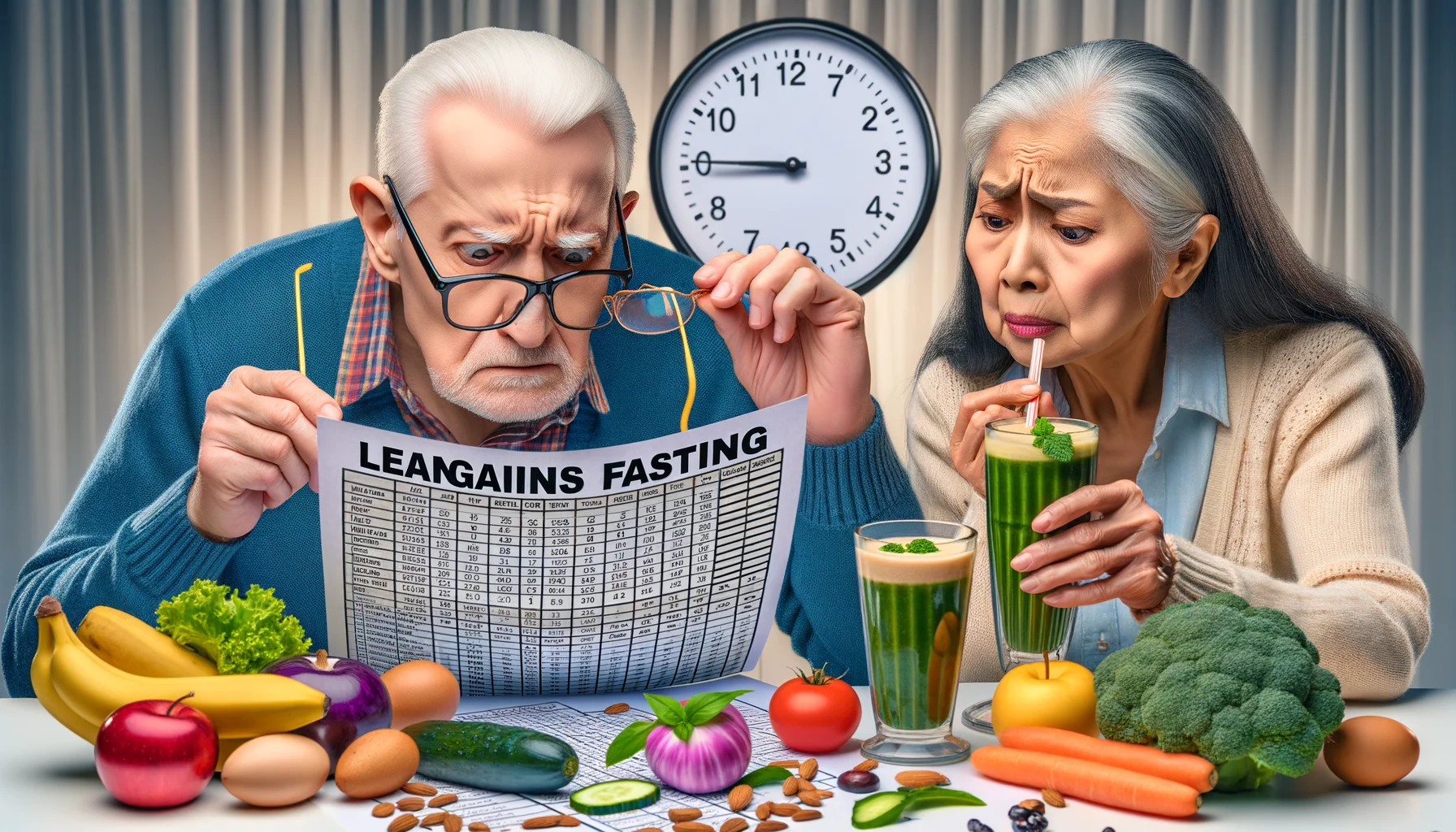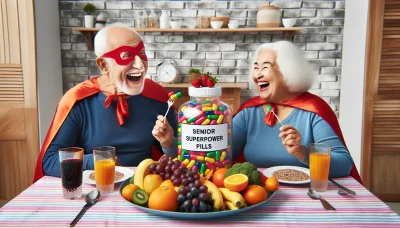Leangains fasting Quiz
Test Your Knowledge
Question of
Understanding Leangains Fasting
The Basics of Leangains Protocol
Leangains is a revolutionary approach to intermittent fasting that combines a 16-hour fast with an 8-hour eating window. This method is designed to optimize fat loss and muscle gain, leveraging the natural hormonal fluctuations of the body. It's not just about skipping meals; it's about strategic timing and nutritional choices to enhance your fitness goals.
Defining the 16/8 Fasting Window: The core of the Leangains protocol lies in its fasting window, where you abstain from caloric intake for 16 consecutive hours. This period typically includes the hours spent sleeping, making it more manageable. The remaining 8 hours are your opportunity to fuel your body with nutrient-dense foods.
The Role of Macronutrients: In the Leangains method, macronutrient distribution is key. High protein intake is paramount, while carbs and fats are carefully balanced depending on workout schedules. Understanding and tracking your macros can lead to more effective results and better overall health.
Timing Your Meals for Optimal Results: The timing of your meals can significantly impact your progress. Aligning your largest meal post-workout maximizes nutrient uptake and muscle recovery. Planning your eating schedule around your lifestyle ensures consistency and sustainability.
Benefits of Leangains Fasting
The benefits of Leangains fasting extend beyond aesthetics; it's a lifestyle that promotes overall well-being. By following this protocol, many individuals report significant changes in their body composition, often seeing an increase in lean muscle mass while decreasing body fat.
Weight Loss and Body Composition: One of the most compelling advantages of Leangains is its ability to transform your physique. It encourages the body to burn fat for fuel during fasting periods, leading to weight loss without sacrificing muscle massa win-win for fitness enthusiasts!
Improved Metabolic Health: Intermittent fasting through the Leangains model can improve insulin sensitivity and blood sugar control. These metabolic benefits contribute to a reduced risk of chronic diseases such as type 2 diabetes and cardiovascular issues.
Enhanced Cognitive Function: Many adherents report heightened mental clarity and focus during fasting periods. The brain-derived neurotrophic factor (BDNF) increases during fasting, which may support brain health and cognitive function.
Common Challenges and Solutions
While Leangains offers numerous benefits, it's not without its challenges. Understanding how to navigate these hurdles can make all the difference in successfully sticking with the program.
- Hunger Management Tips: - Drink plenty of water or calorie-free beverages to stave off hunger. - Stay busy during fasting hours to keep your mind off food. - Consume fiber-rich foods in your eating window to promote satiety. - Allow time for adaptation; initial hunger pangs often subside after a few weeks.
- Socializing While Fasting: - Plan social events during your eating window when possible. - If you must socialize during a fast, opt for non-caloric drinks like water or black coffee. - Be upfront with friends about your fasting schedule; most will be supportive.
- Diet Adjustments for Training Days: - On workout days, prioritize carbs post-training to replenish glycogen stores. - Adjust calorie intake based on activity level; more on training days, less on rest days. - Consider a protein shake if training falls within the fasting period to aid muscle recovery.
Managing Hunger During Fasting Periods: Hunger can be one of the most challenging aspects when starting out with intermittent fasting. Drinking water or herbal teas can help curb appetite during fasting windows. Over time, many find their bodies adapt to the new eating pattern, experiencing less hunger as they settle into their routine.
Balancing Social Life and Fasting: Navigating social situations while maintaining a strict eating schedule can be tough but not impossible. Planning ahead is crucialtry scheduling social gatherings within your feeding times or suggesting activities that don't revolve around food.
Adjusting the Diet for Training Days
Differentiating Your Eating Plan: Tailoring your diet on training days is essential for optimal performance and recovery. Increasing carbohydrate intake post-exercise aids in muscle repair and replenishment of energy stores.
Maintaining Nutritional Balance: It's important not just to adjust calories but also to maintain a balance between proteins, fats, and carbohydrates based on activity levels. Consuming lean proteins throughout both training and rest days supports consistent muscle repair.
Implementing Leangains in Your Routine
Creating a Leangains Meal Plan
Calculating Your Caloric Needs is the cornerstone of a successful Leangains meal plan. Begin by determining your Total Daily Energy Expenditure (TDEE) this is the number of calories your body burns in a day. Adjust this number based on whether your goal is to lose fat, gain muscle, or maintain your weight. A slight caloric deficit or surplus is key, depending on your goals.
Choosing Foods for Your Feeding Window can make or break your Leangains diet. Prioritize whole foods like lean proteins, complex carbs, and healthy fats. Ensure you're getting enough fiber and micronutrients by incorporating a variety of fruits and vegetables into your meals. Remember, food quality matters as much as quantity.
Meal Prep Strategies for Success: Being prepared is essential. Cook meals in bulk and portion them out to save time and resist temptation during the fasting period. Always have healthy snacks on hand to break your fast gently, such as nuts or yogurt, to avoid overeating when the feeding window opens.
- Order Your Meals: Start with lighter foods and move towards denser meals.
- Hydrate: Drink plenty of water throughout the day to aid digestion and satiety.
- Mind Your Macros: Balance macronutrients to support muscle growth and recovery.
- Avoid Empty Calories: Skip sugary drinks and high-calorie junk foods that provide little nutritional value.
Exercise and Leangains Fasting
Structuring Workouts Around Fasting: Time your workouts just before your feeding window for optimal energy use and recovery. This takes advantage of the hormonal changes during fasting that may benefit muscle gain and fat loss. Pre-workout nutrition can be minimal or fasted depending on personal tolerance.
Importance of Resistance Training : Resistance training is non-negotiable in the Leangains protocol. It's designed to increase muscle mass and strength, thereby boosting metabolism. Focus on compound lifts like squats, deadlifts, bench presses, and rows for maximum efficiency.
Recovery and Nutrition Timing : Post-workout nutrition is critical in the Leangains method. Consume protein-rich foods along with some carbohydrates after exercising to aid muscle repair and replenish glycogen stores. Allow sufficient rest between training sessions for muscle recovery.
Monitoring Progress and Making Adjustments
Tracking Body Measurements and Performance : Regularly measuring body composition and performance metrics provides insight into your progress. Use tools like calipers for body fat measurements or track lift numbers at the gym to ensure you're moving towards your goals.
When to Tweak Your Caloric Intake : If weight loss plateaus or you're not gaining muscle at the expected rate, reassess your caloric intake. A plateau may signal it's time to adjust calories slightly while keeping an eye on macronutrient balance.
Signs You Need to Alter Your Fasting Schedule: Listen to your body if you're feeling weak during workouts or overly hungry at night, consider adjusting your fasting window. Tailoring the schedule to fit your lifestyle can improve adherence and sustainability of the Leangains method.
Leangains vs. Other Intermittent Fasting Methods
Comparing Leangains to 5:2 Diet
Overview of the 5:2 Approach
The 5:2 diet is a form of intermittent fasting that involves eating normally for five days of the week while restricting calories significantly on the other two days. This method is known for its flexibility and ease of integration into different lifestyles, allowing individuals to choose their fasting days based on their schedules.
The Leangains protocol, on the other hand, emphasizes a daily fasting period of 16 hours coupled with an 8-hour eating window. It also incorporates specific workout routines and nutritional guidelines aimed at improving body composition and strength.
Pros and Cons of Each Method
Leangains is celebrated for its structured approach, which can be particularly beneficial for those who thrive on routine and are focused on fitness goals. However, it may require more discipline due to its daily commitment to fasting and exercise.
The 5:2 diet offers greater flexibility, making it potentially more sustainable long-term for some individuals. Yet, the calorie restriction on fasting days can be challenging and may not be suitable for everyone, especially those with high energy demands.
Deciding Which Is Right for You
Selecting between Leangains and the 5:2 diet depends largely on personal preferences, lifestyle, and specific health goals. It's crucial to consider factors like daily routine, exercise habits, and dietary needs before committing to a fasting method.
Consultation with a healthcare provider or nutritionist can provide tailored advice and ensure that the chosen method aligns with one's health status and objectives. Here are some tips when choosing an intermittent fasting method:
- Evaluate your daily schedule to determine which fasting pattern is most manageable.
- Consider your fitness goals; opt for Leangains if strength training is a priority.
- Assess your ability to handle calorie restriction; start slowly if new to fasting.
- Listen to your body's signals; adapt the method if you experience negative symptoms.
- Maintain a balanced diet rich in nutrients during non-fasting periods.
- Stay hydrated throughout the day, especially during fasting windows.
- Prioritize sleep and stress management as they can impact fasting efficacy.
- Seek professional advice if you have underlying health conditions or concerns.
Leangains and Eat-Stop-Eat
Understanding Eat-Stop-Eat Protocol
Eat-Stop-Eat is an intermittent fasting strategy that involves one or two 24-hour fasts per week. During these fasts, no food is consumed from dinner one day until dinner the next day. This approach aims at creating a caloric deficit while still allowing individuals to enjoy meals every day.
In contrast, Leangains' shorter but more frequent fasting periods may be perceived as less extreme but require consistency in daily practice. Its focus extends beyond weight loss to include detailed guidance on macronutrient distribution and timing around workouts.
Differences in Fasting Duration and Frequency
The primary difference between Eat-Stop-Eat and Leangains lies in the duration and frequency of their fasting intervals. Eat-Stop-Eat's full-day fasts are less frequent but longer in duration compared to Leangains' daily approach.
This difference makes each method appealing based on individual preferencessome may find it easier to fast completely for full days intermittently while others may prefer the regularity of a daily eating window as prescribed by Leangains.
Combining Elements from Both Diets
Innovative dieters sometimes experiment with combining elements from both Leangains and Eat-Stop-Eat, tailoring their intermittent fasting experience to what feels best for their bodies. This hybrid approach allows individuals to adapt their eating patterns based on personal goals, responses, and lifestyle changes.
A flexible mindset enables dieters to switch between methods or adjust their protocols as needed. The key is monitoring progress and ensuring that any combined approach continues to support one's health and wellness objectives effectively.
Leangains and Time-Restricted Feeding (TRF)
Exploring Other TRF Schedules
Time-Restricted Feeding (TRF) encompasses various intermittent fasting schedules that confine eating within certain hours of the day. Common TRF schedules include 12:12, where eating is restricted to a 12-hour window each day, or more rigorous patterns like 20:4, also known as the Warrior Diet.
Different TRF approaches cater to varying levels of intensity and personal preferences. While some individuals may find success with longer eating windows, others may benefit from tighter constraints depending on their health goals and daily routines.
How Leangains Stands Out from TRF
The Leangains model is distinct within the TRF category due to its combination of a moderate-length eating window with specific dietary recommendations geared towards athletes and those looking to build muscle mass while losing fat. It also places emphasis on meal timing in relation to resistance training sessions.
This specificity sets Leangains apart from other TRF methods that might focus solely on the timing aspect without delving into workout optimization or macronutrient breakdowns tailored for muscle development and recovery.
Personalizing Your Intermittent Fasting Plan
An effective intermittent fasting plan takes into account individual differences in metabolism, lifestyle, and fitness levels. Personalization is keywhat works for one person might not work for another even within the same TRF framework such as Leangains.
Critical self-assessment along with trial-and-error helps refine any intermittent fasting strategy over time. Adjustments should be made based on feedback from one's own body including energy levels, hunger cues, performance metrics, and overall well-being.
Nutrition Essentials for Leangains Practitioners
Macronutrient Distribution in Leangains Diet
The Leangains method hinges on precise macronutrient distribution to maximize muscle gains and fat loss. It's not just about how much you eat, but also what you eat. Ensuring the right balance of proteins, carbs, and fats is crucial for optimal results.
Protein Intake for Muscle Growth and Maintenance is a cornerstone of the Leangains diet. A high protein intake supports muscle repair and growth, especially after training sessions. Aim for a rich source of protein at every meal to maintain muscle mass while shedding fat.
Managing Carbs and Fats in Your Eating Window: Carbohydrates are your body's primary energy source, especially on training days. On rest days, shift focus towards fats while keeping carbs lower. This cycling approach aligns with your body's varying energy needs.
Adjusting Macros Based on Training Intensity: Listen to your body! If you're powering through intense workouts, you may need more carbs for energy. Conversely, ease up on carbs during lighter training periods or rest days to optimize fat burning.
Importance of Micronutrients and Hydration
While macronutrients get most of the attention in dieting circles, micronutrients and hydration play an equally vital role. They keep your bodily functions running smoothlya must for any serious Leangains practitioner.
Essential Vitamins and Minerals for Health: These micronutrients support everything from immune function to bone health. Ensure your diet includes a variety of fruits, vegetables, lean meats, and whole grains to cover all your bases.
The Role of Water During Fasting and Feeding Phases: Hydration is key! Water helps with digestion and nutrient absorption during feeding times, and it's essential for maintaining energy levels while fasting.
Supplementation Considerations for Fasters: Sometimes food alone isn't enough. Consider a multivitamin or specific supplements like Vitamin D or Omega-3s to fill any nutritional gaps in your diet.
Pre- and Post-Workout Nutrition Tips
Fueling Your Body for Exercise: Before hitting the gym, consume a meal rich in protein with moderate carbohydrates to sustain energy levels throughout your workout. This will help you push harder and maximize performance.
- Eat 1-2 hours before training to give your body time to digest.
- Select complex carbs like oats or sweet potatoes for sustained energy release.
- Avoid high-fat foods pre-workout as they can slow digestion and make you feel sluggish.
- Incorporate a small amount of caffeine for an extra boost if needed.
Optimal Foods for Muscle Recovery: After working out, its critical to replenish glycogen stores with carbs and provide protein for muscle repair. The ideal post-workout meal kickstarts recovery so you can bounce back faster.
Timing Your Meals Around Training Sessions: The timing of your nutrition is as important as what you consume. A strategic approach ensures that nutrients are available when your body needs them mostfor both fueling workouts and facilitating recovery thereafter.
Advanced Techniques in Leangains Fasting
Cycling Calories and Carbohydrates
Mastering the art of calorie and carbohydrate cycling can revolutionize your Leangains fasting results. By varying your intake, you can stimulate fat loss while maintaining, or even building, muscle mass. It's a strategic dance with macronutrients that demands precision and consistency.
Implementing Carb Cycling for Fat Loss and Muscle Gain involves alternating between high-carb days to fuel intense workouts and low-carb days to promote fat burning. This seesaw approach aligns your energy intake with your body's needs, optimizing the anabolic response of muscle tissue.
Weekly Calorie Distribution for Optimal Results is all about timing. Save those calorie surpluses for heavy lifting days when your muscles are crying out for glycogen. On rest days or light activity days, scale back the calories to encourage your body to dip into its fat stores.
Tailoring Your Diet to Energy Demands is not just smart; it's essential. Listen to your body's cues and adjust your diet accordingly. Fuel up when you're active, pare down when you're not, and watch as your body composition starts to shift in your favor.
Refeed Days and Diet Breaks
A refeed day isn't just a cheat day; it's a calculated boost in calories and carbs that can kickstart metabolism and replenish glycogen. When done right, it supports continued fat loss by preventing metabolic slow-down.
The Purpose of Refeeding in Leangains is twofold: physiological replenishment and psychological relief. Strategically increasing caloric intake can help maintain lean mass and leptin levels, both critical for sustained fat loss.
- Planning a Diet Break Strategically : Schedule these breaks during periods of plateau or when morale is waning. A week-long break every 8-12 weeks can prevent burnout and stalling progress.
- Psychological Benefits of Periodic Refeeds : They are not just physical escapes from dietary restriction but mental ones too. This respite can renew motivation and adherence, making them invaluable tools in the long-term dieting arsenal.
- Avoid turning refeeds into binges; keep it controlled with an emphasis on carbohydrates rather than fats.
- Maintain protein intake during refeeds to support muscle synthesis while enjoying the metabolic benefits of increased carbs.
- Use refeeds as an opportunity to consume nutrient-dense foods that might be restricted on normal fasting days.
Combining Leangains with Ketogenic Dieting
The ketogenic diet slashes carbs to the bone, pushing your body into ketosis where it burns fat for fuel. This low-carb approach can be a potent ally to intermittent fasting, potentially amplifying fat loss and mental clarity.
Understanding the Ketogenic Approach : It's more than just cutting carbs; it's about hitting specific macronutrient ratioshigh fats, moderate proteins, minimal carbsto switch the body's primary energy source from glucose to ketones.
Potential Synergies Between Leangains and Keto : When combined with Leangains' fasting protocol, keto has the potential to accelerate fat loss while preserving lean mass. It may also help control hunger better than other diets during fasting windows.
Managing Energy Levels and Performance : The key challenge is ensuring that energy levels remain high enough to sustain intense workouts. Strategic supplementation with electrolytes and possibly cyclically reintroducing carbs around workout times can help maintain peak performance.
Troubleshooting Common Issues in Leangains Fasting
Plateaus in Weight Loss and Muscle Gain
Hitting a plateau can be incredibly frustrating, but it's a common part of any fitness journey. When progress in weight loss or muscle gain stalls, it's crucial to evaluate your routine. Dietary habits, workout intensity, and recovery periods all play significant roles in breaking through a plateau. Adjusting these factors can often kickstart progress.
Identifying Causes of Stagnation requires a close look at your caloric intake and expenditure. Are you tracking your food accurately? Have there been changes in your activity level? Sometimes, the body simply gets used to a certain routine, necessitating changes to continue progress.
Strategies to Overcome Plateaus include varying your workout regimen, increasing protein intake, or incorporating refeed days to boost metabolism. It's also key to ensure that you're getting enough rest between workouts for optimal muscle recovery and growth.
When to Seek Professional Advice: If self-assessment and adjustments fail to yield results, consulting with a nutritionist or personal trainer can provide personalized insights and strategies tailored specifically for your body and goals.
Dealing with Low Energy and Fatigue
Assessing Your Dietary Intake is the first step when facing low energy levels during fasting. It's essential to consume nutrient-dense foods that provide sustained energy within your eating window. This includes a balance of macronutrientsproteins, fats, and carbohydratesand micronutrients from fruits and vegetables.
- Eat complex carbs for long-lasting energy.
- Incorporate healthy fats that support hormone functions.
- Select lean protein sources to fuel muscle repair and growth.
- Stay hydrated as dehydration can cause fatigue.
The Importance of Sleep and Stress Management cannot be overstated. Poor sleep quality can sabotage fasting benefits by affecting hunger hormones and energy levels. Stress also impacts cortisol levels which can lead to fatigue. Aim for 7-9 hours of sleep per night and use stress-reduction techniques such as meditation or yoga.
Adapting Your Fasting Schedule for Better Energy: If you experience persistent low energy, consider adjusting the timing of your fasting period. Listen to your bodyif training in the morning feels draining, try shifting exercise sessions to later in the day when you have consumed some calories.
Digestive Health During Intermittent Fasting
Focusing on digestive health is crucial during intermittent fasting. The foods chosen during your feeding window should promote gut health while providing necessary nutrients. High-fiber foods like vegetables, fruits, whole grains, and legumes can support healthy digestion and prevent constipation.
Managing Bloating and Discomfort: To minimize bloating, avoid overeating in your feeding windowespecially with foods high in artificial sweeteners or those that are overly processed. Eating slowly and mindfully also aids digestion by reducing the amount of air swallowed with food.
Recognizing Food Sensitivities and Intolerances: Intermittent fasting may help identify food sensitivities as symptoms become more noticeable when reintroducing foods after a fast. Keeping a food diary can help track potential triggers for digestive issues like bloating, gas or abdominal pain.
Social Aspects and Lifestyle Integration
Balancing Social Events with Fasting
Engaging in social events while following the Leangains protocol can seem challenging, but it's all about balance! Prioritize events that align with your feeding windows, and remember that occasional flexibility won't derail your progress. It's crucial to maintain a positive mindset and not let fasting become a source of stress during social interactions.
When dining out or attending parties, it's essential to have strategies in place. Opt for restaurants with options that fit your dietary needs, and don't hesitate to customize orders to suit your protocol. At parties, focus on the company and conversation, not just the food. With smart choices, you can enjoy the social scene without compromising your goals.
Navigating Dining Out and Parties
Communicating your dietary preferences is key when navigating social dining situations. Be upfront with friends and family about your eating schedule it helps set expectations and reduces potential awkwardness. Remember, most people will respect your dedication to health once they understand it!
- Choose restaurants with diverse menus that offer lean proteins, vegetables, and whole grains.
- Don't shy away from asking for meal modifications restaurants are often happy to accommodate.
- If possible, schedule social outings during your feeding windows to simplify decision-making.
- Stay hydrated drinking water can help you feel full and reduce the temptation to eat outside of planned times.
Enjoying Alcohol Responsibly During Feeding Windows
Alcohol can be part of your lifestyle on the Leangains protocol if consumed responsibly during feeding windows. The key is moderation choose lower-calorie drinks and avoid high-sugar mixers that can sabotage your diet. Always prioritize food over alcohol to meet nutritional goals first!
Traveling While Maintaining Leangains Protocol
Travel doesn't have to disrupt your Leangains routine! Plan ahead by researching food options at your destination or packing snacks that align with your diet. Anticipate challenges and strategize solutions before you depart to stay on track effortlessly.
Planning Ahead for Trips
Finding suitable food options while traveling requires a bit of forethought. Look up restaurants and supermarkets near your accommodation or destinations. If you're staying in a place with kitchen facilities, consider preparing some meals yourself for greater control over what you eat!
Finding Food Options on the Go
On-the-go food options are plentiful if you know where to look! Convenience stores often stock nuts, yogurt, or fruit perfect for quick snacks that fit into the Leangains framework. Don't forget mobile apps; they're great tools for locating eateries that cater to specific dietary needs.
Adjusting Your Fasting Schedule When Traveling
Time zone changes can complicate fasting schedules. Adjust gradually by shifting meal times an hour each day leading up to your trip or immediately upon arrival. Stay flexible sometimes, adapting temporarily is more practical than sticking rigidly to usual routines.
Long-Term Sustainability of Leangains
The true test of any lifestyle change is its long-term sustainability. With Leangains, setting realistic goals paves the way for success without overwhelming yourself. Understand that progress takes time; patience combined with consistent effort yields lasting results!
Setting Realistic Goals and Expectations
Achievable goals are central to maintaining motivation over time. Break down larger objectives into smaller milestones; this makes the journey more manageable and rewarding as you celebrate incremental victories along the way!
Building Habits for Lifelong Health
Habit formation is at the heart of long-term adherence to Leangains. Integrate practices into daily life until they become second nature this might include meal prepping or scheduling workouts consistently. Over time, these habits build a foundation for lifelong health.
Adapting the Protocol as Your Lifestyle Changes
Lifestyles evolve, and so should your approach to Leangains. Be prepared to tweak fasting periods or dietary choices as circumstances change whether due to aging, work demands, or family commitments. Flexibility is vital; what matters is finding a sustainable balance that works for YOU!
Success Stories and Motivation
Transformations Achieved with Leangains
The Leangains method has revolutionized the fitness community with its stunning transformations. Individuals from all walks of life have seen remarkable changes in their physique and overall health. Their journey, often depicted through compelling before-and-after photos, serves as a beacon of possibility for newcomers.
Documenting progress is a cornerstone of the Leangains philosophy. Visual evidence not only boosts motivation but also provides a tangible record of change. It's thrilling to witness the physical metamorphosis that unfolds over weeks and months of dedication!
But what are the key factors behind these success stories? It's a blend of disciplined adherence to the fasting protocol, precise nutrition, and targeted training regimens. Success with Leangains isn't accidental; it's the outcome of a well-executed plan!
Learning from others is invaluable. The shared experiences within the Leangains community highlight common challenges and innovative solutions, offering new perspectives to those on their transformation journey.
Staying Motivated During Tough Times
The path to transformation is not without its hurdles. However, finding support within the Leangains community can turn obstacles into stepping stones. There's an incredible sense of camaraderie among members who encourage and uplift one another.
Setting milestones is crucial for maintaining focus. Celebrating small victories along the way fuels the drive to reach larger goals. It's not just about the end result; it's about appreciating each step forward.
- Start Small: Begin with achievable targets to avoid feeling overwhelmed.
- Reward Yourself: Treat yourself for hitting milestones to maintain enthusiasm.
- Stay Positive: Keep a positive mindset even when progress seems slow.
- Visualize Success: Regularly visualize your goals to keep them front and center.
- Mix It Up: Vary your routine to prevent boredom and plateauing effects.
- Lean on Community: Engage with others for support and accountability.
- Reflect on Progress: Take time to reflect on how far you've come.
Coping mechanisms are vital when facing rough days. It's about developing strategies that resonate personally, whether that's through meditation, journaling, or simply taking a rest day. Remember, it's okay to have an off day; what matters is bouncing back!
Continuous Learning and Education
To excel with Leangains, staying informed is key! Keeping up with the latest research on intermittent fasting ensures that your approach remains effective and scientifically sound. Knowledge is power, especially when it comes to body transformation.
Educational events like workshops, seminars, and webinars are fantastic opportunities for growth. They offer deep dives into topics related to intermittent fasting, nutrition, and exercise scienceessential knowledge for anyone serious about their health journey.
Diving into books and articles penned by experts offers insights that can refine your approach to Leangains. Whether its understanding the nuances of nutrient timing or mastering workout techniques, theres always more to learn!












